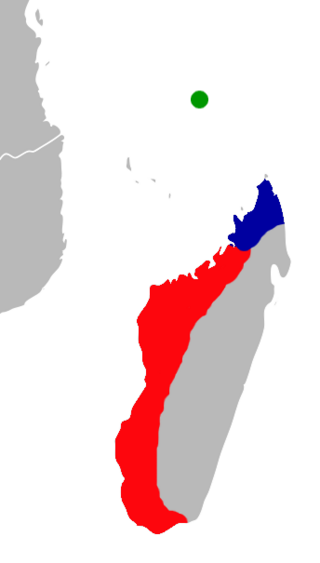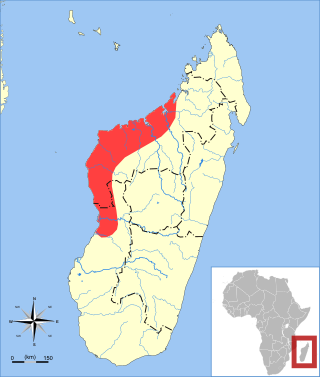
Spix’s disk-winged bat, is a species of bat in the family Thyropteridae. It is native to the Americas from Mexico to Brazil. The most prominent anatomical feature of this bat, which distinguishes it from other species, is the disks on its thumbs and hind feet. These circular disks act as suction cups, allowing the bats to cling onto and move along smooth surfaces.

Peters's wrinkle-lipped bat, also called Peters's goblin bat, is a species of bat in the family Molossidae, the free-tailed bats. It is endemic to Madagascar, where it is widespread and in some areas abundant. It commonly roosts in human-made structures, sometimes in colonies with other free-tailed bat species. It forages in the open, often in agricultural areas. The bat is sexually dimorphic, with males larger than females.

The Madagascan fruit bat is a species of bat in the family Pteropodidae. It is endemic to Madagascar and is listed as "Vulnerable" by the IUCN because it is hunted as bushmeat.

The Madagascar sucker-footed bat, Old World sucker-footed bat, or simply sucker-footed bat is a species of bat in the family Myzopodidae endemic to Madagascar, especially in the eastern part of the forests. The genus was thought to be monospecific until a second species, Myzopoda schliemanni, was discovered in the central western lowlands. It was classified as Vulnerable in the 1996 IUCN Red List of Threatened Species but is now known to be more abundant and was reclassified in 2008 as of "Least Concern".

Myzopoda, which has two described species, is the only genus in the bat family Myzopodidae. Myzopodidae is unique as the only family of bats presently endemic to Madagascar. However, fossil discoveries indicate that the family has an ancient lineage in Africa, extending from the Pleistocene as far back as the late Eocene. Based on nuclear DNA sequence data, Myzopodidae appears to be basal in the Gondwanan superfamily Noctilionoidea, most of whose members are neotropical. The origin and initial diversification of Noctilionoidea may have occurred in Africa prior to their dispersal to Australia and South America, probably via Antarctica. On the basis of fossil and molecular clock evidence, myzopodids are estimated to have split off from the rest of Noctilionoidea about 50 million years ago.

The Madagascan flying fox, Madagascar flying-fox, or Madagascar fruit bat is a species of megabat in the genus Pteropus. It is endemic to Madagascar. Its natural habitats are diverse, and include moist lowland forests, dry forests, succulent woodlands, and spiny thickets, and mangroves. It eats figs and other fruits, flowers, and leaves. It is threatened by habitat loss.

The Madagascan rousette or Madagascar rousette, is a species of megabat in the family Pteropodidae endemic to Madagascar. Its natural habitat is subtropical or tropical dry forests.

Grandidier's trident bat is a species of bat in the family Hipposideridae endemic to Madagascar. It was formerly assigned to the genus Triaenops, but is now placed in the separate genus Paratriaenops.

Pipistrellus raceyi, also known as Racey's pipistrelle, is a bat from Madagascar, in the genus Pipistrellus. Although unidentified species of Pipistrellus had been previously reported from Madagascar since the 1990s, P. raceyi was not formally named until 2006. It is apparently most closely related to the Asian species P. endoi, P. paterculus, and P. abramus, and its ancestors probably reached Madagascar from Asia. P. raceyi has been recorded at four sites, two in the eastern and two in the western lowlands. In the east, it is found in open areas and has been found roosting in a building; in the west it occurs in dry forest. Because of uncertainties about its ecology, it is listed as "Data Deficient" on the IUCN Red List.

A sucker in zoology is a specialised attachment organ of an animal. It acts as an adhesion device in parasitic worms, several flatworms, cephalopods, certain fishes, amphibians, and bats. It is a muscular structure for suction on a host or substrate. In parasitic annelids, flatworms and roundworms, suckers are the organs of attachment to the host tissues. In tapeworms and flukes, they are a parasitic adaptation for attachment on the internal tissues of the host, such as intestines and blood vessels. In roundworms and flatworms they serve as attachment between individuals particularly during mating. In annelids, a sucker can be both a functional mouth and a locomotory organ. The structure and number of suckers are often used as basic taxonomic diagnosis between different species, since they are unique in each species. In tapeworms there are two distinct classes of suckers, namely "bothridia" for true suckers, and "bothria" for false suckers. In digeneal flukes there are usually an oral sucker at the mouth and a ventral sucker posterior to the mouth. Roundworms have their sucker just in front of the anus; hence it is often called a pre-anal sucker.

The Madagascar free-tailed bat or Malagasy giant mastiff bat is a species of free-tailed bat formerly included as a subspecies of the large-eared free-tailed bat, but that was later considered to be a distinct, Malagasy species. The Madagascar free-tailed bat is endemic to northern, western, and southern Madagascar.

The Marovaza yellow bat or Marovaza house bat is a species of bat found in Madagascar.

Neoromicia robtertsi is a species of vesper bat found in Madagascar. It is a recently described species, as it was first described in 2012.

The Malagasy yellow bat, sometimes known as the western yellow bat, is a species of vesper bat endemic to Madagascar.

The western sheath-tailed bat is a species of sac-winged bat found in Madagascar.
Miniopterus newtoni is a species of bat that is endemic to São Tomé and Príncipe.
The Kirindy serotine is a species of vesper bat in the family Vespertilionidae. It occurs in the central and south-central portions of western Madagascar. As of the most recent IUCN assessment in May 2016, it is of least concern.
















